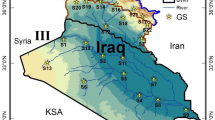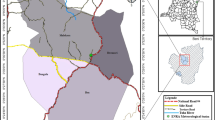Abstract
High-resolution precipitation datasets are used for numerous applications. However, depending on the procedures for obtaining these products, such as number of observations, quality checking, error-correction procedures, and interpolation techniques, they include many uncertainties. Therefore, the accuracy of these products needs to be evaluated over different regions. In this study, the Iranian National Dataset (INDS), a new 1 × 1 km precipitation dataset based on precipitation data of 1,441 quality-controlled stations for the climatic period from 1961 to 2005, was constructed using the digital elevation model, correlation method, and Kriging interpolation procedure. Iran's annual precipitation values at grids and stations were extracted from Climatic Research Unit (CRU) CL 2.0, CRU TS 3.10.01, and WorldClim datasets, and differences between corresponding values in each of the three datasets and INDS were calculated and analyzed. The coefficient of determination (R 2) between the national network stations' data and the CRU CL 2.0, CRU TS 3.10.01, and WorldClim datasets were 0.50, 0.13, and 0.62, respectively. Moreover, R 2 values between the grids of each dataset and INDS were 0.51, 0.40, and 0.60, respectively. To determine the global datasets' efficiency for displaying temporal patterns of precipitation, the monthly values gathered from them at 11 stations (as representative of Iran's various precipitation regimes) were compared with the real values at these stations. The results showed that in term of temporal patterns, the concurrences among the three global datasets and the INDS was more acceptable, especially in the case of CRU CL 2.0. In general, it is concluded that the global datasets could be deployed for the primary assessment of the annual precipitation distribution; however, for more precise studies, use of local data is highly recommended.







Similar content being viewed by others
References
Adle AH (1960) Climatic regions and vegetation in Iran. University of Tehran Press, Tehran, p. 144
Alijani B (2008) Effect of the Zagros mountains on the spatial distribution of precipitation. J Mt Sci 5(3):218–231
Asakereh H (2007) Spatio-temporal changes of Iran inland precipitation during recent decades. Geogr Dev 5(10):145–164
Beck C, Grieser J, Rudolf B, Schneider U (2005) A new monthly precipitation climatology for the global land areas for the period 1951 to 2000. Geophys Res Abstr 7:07154
Booth TH, Jones PG (1998) Identifying climatically suitable areas for growing particular trees in Latin America. For Ecol Manag 108:167–173
Brohan P, Kennedy JJ, Harris I, Tett SFB, Jones PD (2006) Uncertainty estimates in regional and global observed temperature changes: a new dataset from 1850. J Geophys Res 111(d12), D12106
Chen M, Xie P, Janowiak JE, Arkin PA (2002) Global land precipitation: a 50-yr monthly analysis based on gauge observations. J Hydromet 3:249–266
Cramer W, Fischer A (1996) Data requirements for global terrestrial ecosystem modelling. In: Walker et al. (ed.) Global change and terrestrial ecosystems. Cambridge University Press, Cambridge, MA, pp. 530–565
Dai A, Del Genio AD (1997) Surface observed global land precipitation variations during 1900–1988. J Clim 10:2943–2962
Dinku T, Connor SJ, Ceccato P, Ropelewski CF (2008) Comparison of global gridded precipitation products over a mountainous region of Africa. Int J Climatol 28(12):1627–1638
Ganji MH (1955) The climate of Iran. Bull de Soc Geogr 28:195–199
Ghayur H, Masoudiyan SA (1996) An spatial analysis of elevation-precipitation models (case study; Iran). Geogr Res 41(2):124–143
Harris I, Jones PD, Osborn TJ, Lister DH (2013) Updated high‐resolution grids of monthly climatic observations—the CRU TS3.10 Dataset. Int J Climatol. doi:10.1002/joc.3711
Hijmans RJ, Cameron SE, Parra JL, Jones PG, Jarvis A (2005) Very high resolution interpolated global terrestrial climate surfaces. Int J Climatol 25:1965–1978
Huffman GJ, Adler RF, Morrissey MM, Bolvin DT, Curtis S, Joyce R, Susskind J (2001) Global precipitation at one-degree daily resolution from multisatellite observations. J Hydromet 2(1):36–50
Jawadi C (1966) Distribution climatiques en Iran. Monographie Meteorol Nat, Paris
Kaviani M (1988) Statistical Investigation of Precipitation Regime of Iran. Growth Geogr Educ 3(13):4–12
Khalili A (1973) Precipitation pattern of central Alburz. Arch Meteo Geophys Bioclimatol Ser B 21(2–3):215–232
Khalili A (1991) Atmospheric precipitation over Iran. Integrated Water Plan of Iran, Jamab Consulting Engineering Co., The Ministry of Energy, Tehran, p 893
Khalili A (2004) Climate of Iran. In: Banaei MH, Bybordi M, Moameni A, Malakouti MJ (eds) The soils of Iran. Soil and Water Research Institute, Tehran, Iran, pp 24–71
Khalili A, Darvish Sefat A, Baradaran-e-rade R, Bazrafshan JA (2004) Method for climatic classification on selianinov system in GIS media (a case study for north west of Iran). Biaban (Desert) 9(2):227–237
Legates DR, Willmott CJ (1990) Mean seasonal and spatial variability in gauge corrected, global precipitation. Int J Climatol 10:111–127
Masoudiyan SA (2008) On precipitation mapping in Iran. J Humanit 30(2):69–80
Mitchell TD, Jones PD (2005) An improved method of constructing a database of monthly climate observations and associated high resolution grids. Int J Climatol 25:693–712
Modarres R, Sarhadi A (2011) Statistically-based regionalization of rainfall climates of Iran. Glob Planet Chang 75(1–2):67–75
Mohammad Pour M (1994) Gradient zones of annual precipitation in Iran. M.Sc. thesis, College of Agriculture and Natural Resources University of Tehran, Iran, 172 p
Mousavi K (1971) Isohyetal map of Iran. The Ministry of Energy, Iran Water and Power Resources Development Co, Tehran
Nadi M (2010) Application of various interpolation techniques of climatic data for determining the most important factors affecting the trees growth at the elevated areas of Chaharbagh Gorgan, M.Sc. thesis, College of Agriculture and Natural Resourses, University of Tehran, Iran, 83 p
New M, Lister D, Hulme M, Makin I (2002) A high-resolution data set of surface climate over global land areas. Clim Res 21:1–25
Nicholls N (1997) Increased Australian wheat yield due to recent climate trends. Nature 387:484–485
Qian T, Dai A, Trenberth KS, Oleson KW (2006) Simulation of global land surface conditions from 1948 to 2004. Part I: forcing data and evaluations. J Hydromet 7:953–975
Rahimi J (2012) Comparison of effective rainfall estimation methods for rainfed wheat crop in several climatic samples of Iran. M.Sc. thesis, College of Agriculture and Natural Resources, University of Tehran, Iran, 103 p
Rahimi J, Ebrahimpour M, Khalili A (2013) Spatial changes of extended De Martonne climatic zones affected by climate change in Iran. Theor Appl Climatol 112(3–4):409–418
Ropelewski CF, Janowiak JE, Halpert MS (1984) The climate anomaly monitoring system (CAMS). Climate Analysis Center, NWS, NOAA, Washington, DC
Rudolf B, Schneider U (1997) The global precipitation climatology project (GPCP) combined precipitation dataset. Bull Am Meteorol Soc 78:5–20
Xie P, Rudolf B, Schneider U, Arkin PA (1996) Gauge-based monthly analysis of global land precipitation from 1971 to 1994. J Geophys Res 101:19023–19034
Author information
Authors and Affiliations
Corresponding author
Rights and permissions
About this article
Cite this article
Khalili, A., Rahimi, J. High-resolution spatiotemporal distribution of precipitation in Iran: a comparative study with three global-precipitation datasets. Theor Appl Climatol 118, 211–221 (2014). https://doi.org/10.1007/s00704-013-1055-1
Received:
Accepted:
Published:
Issue Date:
DOI: https://doi.org/10.1007/s00704-013-1055-1




